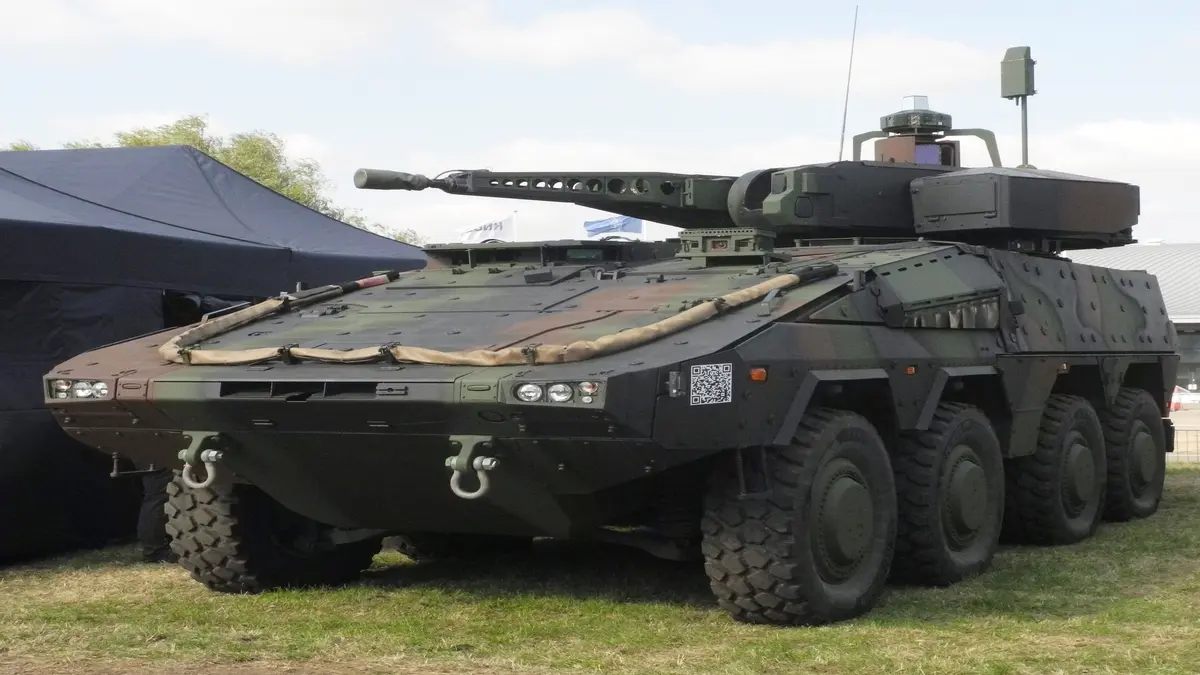“(Berlin – July 30, 2025) – German Defense Minister Boris Pistorius has briefed lawmakers on an unprecedented set of defense procurement initiatives designed to transform the German military into the most capable conventional force in Europe. Of the more than 60 planned orders scheduled for parliamentary approval this year, the most important is the purchase of up to 8,500 armored vehicles over the next decade, including:
- Around 5,000 Boxer multi-role armored vehicles (built by KNDS and Rheinmetall)
- At least 3,500 Patria 6×6 infantry fighting and armored personnel carriers
- The purchase of 20 additional Eurofighter Typhoon fighter jets
- The Patria AMV is a Finnish 8×8 modular armored vehicle designed for multiple roles. Its flexible platform supports a variety of configurations, including APC, IFV, command, ambulance, and fire-support variants with various weapons and sensors. (Jörcher/Wikimedia)
Strategic objectives and budgetary implications
The multi-billion euro purchase push is central to Chancellor Friedrich Merz’s ambition to reduce Germany’s dependence on external partners – particularly the United States – and to assume greater leadership in European defense. To support the plan, the German Bundestag has approved lifting the constitutional debt limit for defense spending, allowing the defense budget to be could reach around €83 billion by 2026 – an increase of €20 billion over 2025 levels. Delivery schedule vehicles and aircraft over the next ten years.
Merz has pledged to meet NATO’s 3.5% of GDP benchmark on defense spending by 2029, a clear sign of Germany’s growing role in the European security architecture.
Capability expansion: Boxer and Patria platforms
The Boxer armored fighting vehicle is a proven modular system used by multiple NATO allies. Configured for combat, logistics, reconnaissance, command-and-control and electronic warfare roles, the Boxer’s versatility is consistent with Germany’s requirements for polyvalent deployment in training, reserve and frontline units.
The Patria 6×6, purchased under the EU’s Common Armored Vehicle System (CAVS), is intended for mechanized infantry operations. The vehicle is ready for mobility and provides protection. Germany has already requested binding offers for an initial tranche of 300 vehicles, with production expected to increase to 1,000 in the full variant over time.
- The Rheinmetall Boxer armoured vehicle is equipped with the Oerlikon Skyranger air defence system. The Boxer is a modular, multi-role platform developed by an international consortium, capable of adapting to different missions through interchangeable modules. (Volpet/Wikimedia)
Strategic impact and regional significance
Enhanced deterrence and interoperability
- Large The acquisition of the armoured platform on a large scale will bridge existing capability gaps and support interoperability with NATO partners in training and missions.
- Germany’s investment signals a shift towards a larger defence industrial base and regional leadership in Europe.
Political dimensions
- The order is part of a broader domestic and regional policy shift advocated by the German leadership to assert greater strategic autonomy.
- State-backed defence investments are expected to boost domestic defence production and export capabilities.
Implementation challenges
- Sustaining high procurement levels for a decade requires stable funding, industrial capacity and logistical infrastructure for storage, spare parts and modernisation.
- The integration of the new platform will require an updated training, doctrine improvement and maintenance structure in the Bundeswehr.
Comprehensive procurement strategy and European context
In addition to armoured vehicles and aircraft, Germany’s plans include additional investments in The proposed acquisition of IRIS-T air defense systems and the Skyranger counter-drone platform is included. These broad initiatives reflect NATO’s evolving priorities and increased strategic responsibilities with changing European defense dynamics.
The weapons purchases complement Germany’s major four-year defense plan of €162 billion, which funds upgrades in the personnel, cyber, air, sea and land sectors.
Conclusion
Germany’s planned order for up to 8,500 armored vehicles – along with tactical aircraft purchases – marks a watershed moment in its military transformation. With strong logistical and combat capabilities, the Bundeswehr is poised to emerge as a leading conventional force in Europe. Successful implementation depends on continued funding, industrial coordination and seamless integration into next-generation platforms.
Read More: Rheinmetall Unveils SSW40 Squad Support Weapon in Live-Fire Demonstration
FAQs
Germany plans to buy around 8,500 armored vehicles over the next decade. This includes around 5,000 Boxer multi-role armored vehicles and at least 3,500 Patria 6×6 infantry fighting vehicles and armored personnel carriers. The vehicles are designed for multiple roles such as combat, logistics, reconnaissance and troop transport, making them versatile for Germany’s military needs.
By investing in thousands of armored vehicles and additional fighter jets, Germany aims to strengthen its defense capabilities and reduce its dependence on other countries such as the US. The move also supports NATO interoperability, allowing Germany to play a greater leadership role in European security and joint military operations.
The German government has lifted the constitutional debt limit for defense spending, with the budget expected to reach around €83 billion by 2026. Chancellor Merz has pledged to meet NATO’s defense spending target of 3.5% of GDP by 2029. This funding will include armored vehicles, fighter jets, air defense systems, and supporting infrastructure.
Yes, Germany faces challenges such as securing stable funding, industrial production capacity, and logistics support for the storage and maintenance of the new vehicles. The Bundeswehr will also need updated training, maintenance, and operational plans to effectively integrate this modern platform.








Leave a Reply